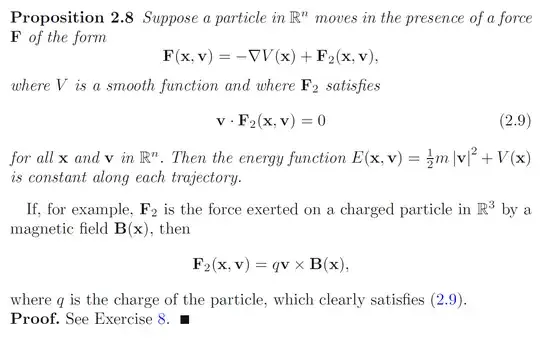This is a generalization of a result commonly discussed in Electrodynamics: magnetic forces do no work.
The idea is that for the energy of the particle to change, some force must do work on the particle due to the work-energy theorem. For the force Hall chose, we can split the analysis in two parts: the potential and the "magnetic" force (I'll give it this name in analogy with Electrodynamics).
The potential can do work, but it also goes in the very definition of energy. It is what we call a conservative force. If it accelerates the particle, the potential energy drops in exchange. Notice there is some sort of equilibrium in here: this force can make the particle go faster, at the expense of the potential getting lower. In general, this means there is a maximum possible speed the particle can get by being accelerated by the force, for eventually one will "run out" of potential energy and all energy will be kinetic. Furthermore, if the particle slows down, the loss of kinetic energy is just being traded for potential energy, which can once again be converted in kinetic and so on.
For the magnetic force, things are quite different. It does not enter the definition of the energy, so in principle it could spoil this idea and either accelerate the particle indefinitely (which would be non-physical) or "steal way energy" (which is the case for friction). What the theorem is showing is that forces that are always normal to the velocity do neither: they can only change direction. The fact they are always orthogonal to the velocity means that the infinitesimal amount of work they can do will always be
$$
\begin{align}
dW &= \mathbf{F \cdot} \text{d}\mathbf{l}, \\
&= \mathbf{F \cdot} \frac{\text{d}\mathbf{l}}{\text{d} t} \ \text{d} t, \\
&= \mathbf{F \cdot v} \ \text{d} t, \\
&= 0,
\end{align}
$$
hence, it can't do any work. As a consequence, it can't change the energy. (I think/hope this doesn't solve Exercise 8, since this argument is usually fair game for physicists, but too sloopy for mathematicians hahaha).
The fact it can't change the energy is a different way of saying it can never lead to the particle speeding up or down. If it increased the energy, it could be possible to turn this extra energy into kinetic and get the particle to move faster. If it decreased the energy, it could be possible to slow down the particle in a similar way.
In short, one possible physical intuition is that if a force is orthogonal to the velocity, it can only change the direction, it can never lead directly or indirectly to an increase or decrease in speed. As commonly stated in Electrodynamics, "magnetic forces do no work".
